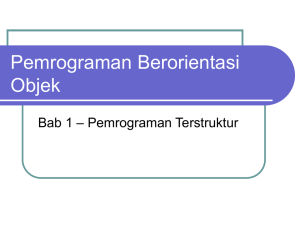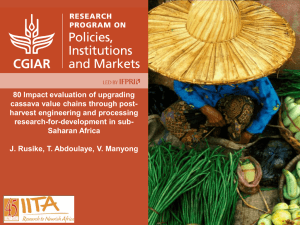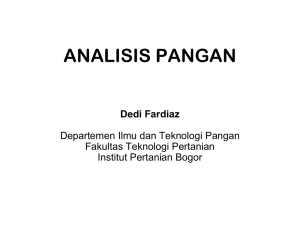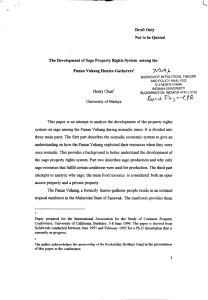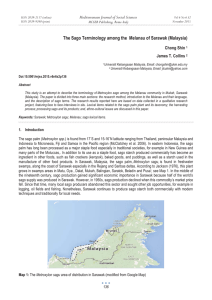adaptation for indonesia staple food sustainability in continuous
advertisement
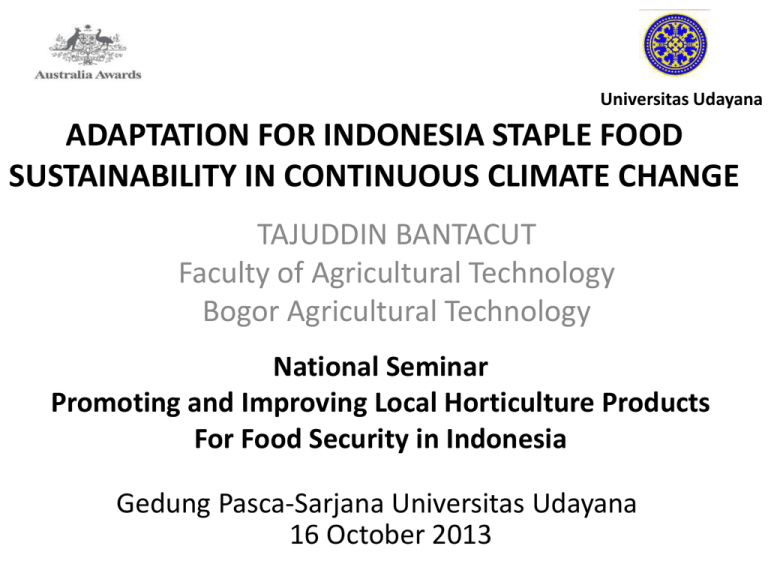
Universitas Udayana ADAPTATION FOR INDONESIA STAPLE FOOD SUSTAINABILITY IN CONTINUOUS CLIMATE CHANGE TAJUDDIN BANTACUT Faculty of Agricultural Technology Bogor Agricultural Technology National Seminar Promoting and Improving Local Horticulture Products For Food Security in Indonesia Gedung Pasca-Sarjana Universitas Udayana 16 October 2013 BOGOR AGRICULTURAL UNIVERSITY FACULTY OF AGRICULTURAL TECHNOLOGY IPB Campus Dramaga Bogor - INDONESIA 16002 TAJUDDIN BANTACUT Agro-industrial Technologist Environmental Engineer (Regional) Development Planner Phone: +62-811-113-851; Fax: +62-251-8623-203 Email : tajuddin@ipb.ac.id; bantacuttajuddin@gmail.com Written Papers 1. 2. 3. 4. 5. 6. 7. Adaptation for Indonesia Staple Food Sustainability in Continuous Climate Change, to be published as issued paper of ARG-Environment and Disaster Mitigation, 2013. Rural Economic and Food Security Development Based on Added Value Formation (Pembangunan Ketahanan Ekonomi dan Pangan Perdesaan Mandiri Berbasis Nilai Tambah). Pangan 22(2): 71-85, 2013 Rationally Optimum Paddy Production: Chances and Challenges (Produksi Padi Optimum Rasional: Peluang dan Tantangan). Pangan 21(2): 281-296, 2012 Sago: Resource for Staple Food Diversification (Sagu: Sumberdaya untuk Penganekaragaman Pangan Pokok). Pangan 20(1): 27-40, 2011. Cassava Based Food Security (Ketahanan Pangan Berbasis Cassava). Pangan 19 (1): 3-13, 2010. Research and Development for Cassava Based Industries (Penelitian dan Pengembangan Untuk Industri Berbasis Cassava). Jurnal Teknologi Industri Pertanian 19(3): 191-202, 2010. Policies Needed to Encourage Flour Agroindustry Development Within the Perspective of Food Security (Kebijakan Pendorong Agroindustri Tepung Dalam Perspektif Ketahanan Pangan). Pangan 18 (53): 32-42, 2009. PRESENTATION OUTLINE 1. INTRODUCTION 2. CLIMATE CHANGE IMPACTS ON CROPS PRODUCTION 3. OPTIMUM RICE PRODUCTION – INDONESIA 4. ADAPTATION TO AVAILABLE FOOD 5. CONCLUSIONS 6. RECOMMENDATIONS INTRODUCTION CLIMATE CHANGE a significant and lasting change in the measurement distribution of weather patterns over periods of decades to millions of years. In the context of agricultural production, it is a change in rainfall resulting in more flood, droughts or intense rain. Weather conditions is unpredictable and its distribution is unstable (i.e. more or fewer extreme weather events) (Gosling, et al., 2011). CLIMATE CHANGE ISSUES • • • • • disturb agricultural production affect water availability create social related problems food supply is insecure in the future necessary to develop adapted agriculture Definition of Staple Food A staple food, sometimes simply referred to as a staple, is a food that is eaten routinely and in such quantities that it constitutes a dominant portion of a standard diet in a given population, supplying a large fraction of the needs for energy-rich materials and generally a significant ... http://en.wikipedia.org/wiki/Staple_food CLIMATE CHANGE IMPACTS ON CROPS PRODUCTION Table 1. Examples of harvesting failure of paddy Case Aceh East Java Year Total Damage (ha) 2013 1,538 2011 125,000 2013 2013 Flood Waspada Online (Local News Paper) Kompas 26-7-2011 6,655 Flood Actual.co 15-8-2013 659 Flood Bisnis Indonesia 153-2013 2013 Banten 2012 10,452 South Sumatera 2013 West Nusatengg ara Source leafhoppers West Sumatera West Java Causes 2,200 Flood damaged dam Okezom.com 11 January 2013 Drought Tempo.co 26-11-2012 280 Flood Sumatera Ekpres Online (10-4-2013) 2012 97 Drought Pikiran Rakyat (31-82012) 2012 2,928 Drought MICOM 18-9-2012 OPTIMUM RICE PRODUCTION - INDONESIA 8 Productivity (ton/ha) 7 6 5 Cina India 4 Indonesia 3 Jepang Thailand 2 Dunia 1 1961 1964 1967 1970 1973 1976 1979 1982 1985 1988 1991 1994 1997 2000 2003 2006 0 World Rice Production, main producers (FAO, 2008) 80 70 60 50 Production (MillionTon) 40 Productivity (Hkg/Ha) 30 Harvested area (Million Ha) 20 10 2000 2001 2002 2003 2004 2005 2006 2007 2008 2009 2010 2011 2012 2013 0 Figure 1. Indonesia rice production profile (Source of Data: BPS, Agriculture Statistics) Table 3. Limit of paddy production – next 3 years Program Parameter Perbaikan Peningkatan Produksi (ton) Intensification Productivity improvement by 1.66 ton/ha (close to China) 12,000,000 Extension (Ekstensifikasi) Land suitable for “sawah” is about 650,000 ha, only 250,000 ha ready to be implemented 2,682,000 Post-harvest handling Land use conversion Total addition to existing production Government plan to reduce to 7,27% Land use function conversion rate of 110,000 ha/year would reach 400,000 ha in about 3 years Integrated improvement through intensification, extensification and post-harvest handling 1,560,000 (1,651,000) 14,591,000 ADAPTATION TO AVAILABLE FOOD Main Food Crops Climate Dependent • Rice • Maize • Wheat • Potatoes Climate Independent • Cassava • Sago • Palm • Some Bananas Consumption Rate of Some Food Stuffs (Gram/cap/day) Jenis Pangan 2005 2006 2007 2008 2009 Laju (%/th) Energy Source Rice 288,30 285,04 274,03 287,26 280,06 -0,50 Corn 9,09 8,34 11,55 8,02 6,07 -7,38 Wheat Flour 23,03 22,60 31,07 30,72 28,28 6,86 Cassava 41,19 34,65 37,09 35,32 26,21 - 8,39 Sweet Potatoes Sago & other tuber crops 10,87 8,71 6,84 7,60 6,56 - 11,99 3,13 2,86 3,33 3,15 2,64 - 2,28 Protein Source Meat 16,10 12,59 17,13 16,21 15,10 1,05 Egg 16,76 15,90 18,58 17,46 17,45 1,71 Milk 3,86 4,05 6,10 5,84 5,36 9,50 Fish 50,91 48,67 49,01 50,45 46,83 -1,30 Soy bean 21,33 22,76 23,63 21,01 19,66 -2,35 Vitamine/Mineral Source Vegetables Fruits 139,13 139,96 158,26 154,3 136,29 0,59 86,96 64,71 93,41 87,40 63,20 -3, 14 Source: Ariani (2010) Wheat flour consumption rate (%) Year Urban Rural Total 1993-1996 59.0 106.4 85.3 1996-1999 -3.3 -3.5 -3.1 1999-2002 12.2 13.4 13.6 2002-2005 6.1 12.5 8.6 Rata-rata 18.5 32.2 26.1 Source: Hardinsyah dan Amalia (2007) Table 2. Nutritive value of some carbohydarate commodities source Content (%, dry basis) Energy (Calorie) Commodity Water Carbohydrate Protein Fat Rice 12.0 80.00 7.00 0.50 359.70 Rice flour 13.0 90.69 7.82 0.80 401.26 Wheat flour 12.0 87.84 10.11 1.48 405.11 Fresh cassava 59.4 92.92 1.71 0.49 157.00 Cassava flour 12.1 93.04 2.43 0.77 393.75 Tapioca 12.0 86.90 0.50 0.30 362.00 Maize 24.0 83.68 10.39 4.47 416.58 Sweet potatoes 68.5 88.57 5.71 2.22 397.14 Potato 64.0 93.61 2.50 1.11 394.44 Sago Starch 14.7 98.49 0.82 0.23 353.00 Caloric ratio to rice 1.00 1.12 1.13 0.44 1.09 1.00 1.16 1.11 1.10 0.98 Table 3. Types of local food made from sago Local name Papeda Kapurung Sagu lempeng Buburnee Bagea Ongol-ongol Origin Maluku and Papua South Sulawesi Papua and Maluku Preparation Sago starch is stirred in cold water to form a suspension and then poured with hot water until thickened and discolored. Stirring is stopped if the color is evenly distributed. Starch is stirred in cold water then thickened with hot water. Pasta is shaped into small spheres with bamboo chopsticks by rotating pasta. Pasta mixed with fish, shrimp and vegetables. Starch chunks rubbed on the screen, then sifted again to get more fine starch and ready to be cooked. The starch then cooked in forna (cooking appliance in Maluku). Sago starch put in forna previously heated, then covered with banana leaves for 15-20 minutes until cooked. Maluku Wet sago starch is made into crumbs and smooth as in the preparation of sago plate, then made the grains with shaking it above a clean surface. The formed granules are roasted in the crock until golden yellowish white or lightly browned. Maluku and Sulawesi Sago starch wrapped in banana leaves or sago leaves and then heated in a pot. To improve nutritional value, sago starch mixed with eggs, walnuts, and salt. Maluku, Papua, Sulawesi, and West Java The preparation is similar to papeda, but mixed with brown sugar. Table 4. Comparison of requirement parameters for Indonesia food crop production Parameter Consumption (kg/capita/year) Productivity (ton/ha)a Land requirement (ha/person/year) Current Indonesia Population (million) Total consumption (ton) Total land requirement (ha) Total land requirement (ha/year) Indonesia Population 2030 (million) Total land requirement 2030 (ha) Land characteristics Land type Water consumption Climate influence Fertilizer used Pest attack Rice 130x 3 0.043 230 29.900.000 9.890.000 4.945.000 b 270 5.805.000 Fertile and irrigated Mainly Wetland (rice field) Very high Very high Very high Very high Cassava1 320y 40 0,008 230 73.600.000 1.840.000 1.840.000c 270 2.160.000 Marginal to fertile Sago2 135z 25 0,0054 230 33.750.000 1.350.000 1.350.000d 270 1.584.000 Swamp and coastal Wet and dry lands Wet land Low Low Low Low High Low Low Low Flour Based Food • Easy to store, transport and distribution • Relatively longer storage life • Relatively easy and simple for food preparation • Availability cooking appliances • Variation of processed foods • Might be processed to rice-like-product PROBLEMS - ACCEPTANCE • Social: eating sago and cassava is deemed to be inappropriate due to difficult to find and hard to prepare. • Phsychology : difficult to accept “low-grade” food into the main menu. • Physiological: the body acceptance to new intake needs adequate adjustments and recognition. CONCLUSIONS • Climate change is and will be continuing to happen that certainly disrupt food production, especially rice. • Disruption to the rice plant has been very common such as droughts, floods, and pests. • Rely on rice as single staple food is very risky. • Staple food diversification is necessary to reduce the risk of hunger in the future. • Cassava and sago are commodities with huge potential and relatively undisturbed climate. • Indonesian must adapt to “new” staple food to survive RECOMMENDATIONS • Research and development: more food more acceptable, feasible and practical. • Menu development to meet the taste of community at large. • Establishing Cassava and Sago Research Center (CSRC). • Extensive introduction and promotion utilising all media networks printing, electronic or virtual media. THANK YOU Carbohydrate content of some food commodities Commodity Energy Carbohydrate (kkal) (g) Calorie ratio to rice Rice 360 78.9 1.00 Cassava 146 34.7 0.41 Sweet Potatoes 123 27.9 0.34 Potatoes 83 19.1 0.24 Breadfruit 108 28.2 0.30 Cassava flour 342 81.4 0.95 Wheat flour 376 85.1 1.05 Sago flour 240 Sweet potatoes flour 367 94.1 1.02 Yellow corn 361 74.3 1.00 Breadfruit flour 302 78.9 0.84 0.67 Definisi Tepung Komposit Tepung komposit adalah campuran dari berbagai jenis tepung, tepung aneka umbi, dengan atau tanpa penambahan tepung tinggi protein (aneka kacang), dengan atau tanpa penambahan tepung serealia, dengan atau tanpa penambahan terigu. Komposisi tepung komposit sesuai dengan produk olahan yang dapat memenuhi permintaan pasar dan preferensi konsumen. Komposisi Tepung Komposit Tujuan pembuatan tepung komposit adalah mendapatkan karakteristik bahan yang sesuai untuk produk olahan yang diinginkan atau mendapatkan sifat fungsional tertentu. Pembuatan tepung komposit adalah untuk mensubstitusi dan atau bahkan menggantikan terigu. Produk berbasis terigu dibagi menjadi dua yaitu produk yang memerlukan pengembangan dan yang tidak memerlukan pengembangan. Aplikasi Tepung Komposit Pada prinsipnya tepung komposit dapat diaplikasikan sangat luas untuk pengolahan berbagai produk pangan yang memerlukan sifat mengembang dan tidak. Untuk produk-produk yang tidak membutuhkan sifat mengembang atau elastis sangat luas seperti produk biscuit, muffin, cakes, dan produk sejenisnya. TEPUNG KOMPOSIT UNTUK PEMBUATAN ROTI TAWAR • Secara umum, penggunaan tepung non terigu untuk substitusi sampai 20% masih menghasilkan roti yang dapat diterima. • Tepung BIMO/MOCAF dapat mensubstitusi sedikit lebih besar dari 20% untuk menghasilkan roti yang masih dapat diterima TEPUNG KOMPOSIT UNTUK PEMBUATAN MIE o Mie yang dibuat dari tepung komposit dengan tepung non terigu sampai 30% mempunyai sifat reologi dan karakter mi yang tidak berubah. o Tepung komposit berupa terigu 80% dan tepung ubikayu 20% yang difortifikasi dengan tepung jagung 5% dapat menghasilkan mi yang sesuai dengan standar (Yulmar, 1997). o Tepung komposit dengan kandungan tepung non terigu sampai 20 % tidak merubah rheologi dapat diterima konsumen dengan baik Contoh PRODUK dengan Komponen Non Terigu Relatif Tinggi Brownish Kukus Ubijalar, Dapat menggunakan tepung ubijalar sampai lebih dari 70% Black Forest Menggunakan Tepung Ubijalar 50%
